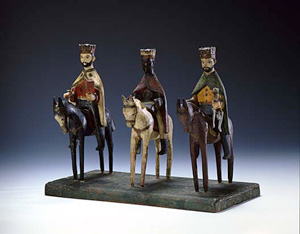« It Takes a Pueblo: Georgia O'Keeffe and Ansel Adams | Eye Level Home
In This Case: Los Reyes Magos
January 6, 2009
Many people mistake days mentioned in the song "The Twelve Days of Christmas" for the days preceding December 25. In actuality, however, the song refers to the twelve days after Christmas. In the United States, our traditions tend to focus on family gatherings, large meals, Christmas trees, Santa Claus, and reindeer. In places across the world, particularly in Spanish speaking countries, January 6 is the main gift-giving holiday. The Day of the Kings, known as the Epiphany in the United States, shares many elements of the Christmas traditions. Children put out treats for the camels, often grass, along with some type of libation for Melchior, Gaspar, and Balthazar on the night of January 5. The kings bring presents only to good boys and girls. Apart from this, each country that celebrates the Day of the Kings has its own unique traditions, like parades, family gatherings or my favorite, eating rosca de reyes (king cake) with figurines hidden inside.
You might be asking yourself what this has to do with the Luce Foundation Center for American Art! On the third-floor mezzanine, in a dimly lit case (due to the material and fragility of the pieces, not because we don’t want you to see them), you will find this wooden sculpture that embodies the Puerto Rican tradition of the Day of the Kings. Los Reyes Magos (The Magi) was created in the late 1800s by Puerto Rico’s most notable family of santeros (carvers of wooden saints), the Caban Group. The three kings were revered as unofficial saints in Puerto Rico, which is most likely why the Caban Group depicted them. This piece breaks from the traditional iconography for the three kings found in western art. Instead of riding camels, the three men are on horseback. Similarly, Melchior, rather than Balthazar, is depicted as the black king, because according to local tradition, the rays of a star burned him.
You can find numerous examples of Latino art, including several depictions of the three kings, in the Luce Foundation Center. Case 21b, which houses Los Reyes Magos, showcases pieces from the collection of Puerto Rican historian and art collector Teodoro Vidal. You can also read more about Latino art in the American Art Museum’s collection in our online exhibit.
Mucha gente cree que la canción “Los 12 días de Navidad” se refiere a los doce días antes de la Navidad. En realidad, la canción se refiere a los 12 días después de Navidad. En los Estados Unidos, nuestras tradiciones navideñas tienen que ver con reuniones de la familia, grandes comidas, árboles de navidad, renos y Papá Noel. En muchos países del mundo, especialmente en los países hispanohablantes, el 6 de enero es el principal día festivo para dar y recibir regalos. Conocido como la Epifanía en los EEUU, el día de los Reyes Magos tiene mucho en común con nuestras tradiciones navideñas. En vísperas del día de los Reyes Magos, los niños dejan comida para los camellos y algo de beber para Melchor, Gaspar y Baltasar. Los Reyes solo traen regalos para los niños que se han portado bien durante todo el año. Además de eso, cada país tiene sus propias tradiciones, como desfiles, reuniones con la familia o mi favorita, la rosca de reyes con muñequitos escondidos adentro.
¿Qué tiene que ver el día de los Reyes Magos con el Luce Foundation Center? Por el tercer entrepiso, en una muestra poco iluminada (debido al material y la fragilidad de los objetos y no porque queramos que no se vea), se puede encontrar una escultura de madera que muestra unas de las tradiciones puertorriqueñas. Los Reyes Magos fue creado a finales del siglo diecinueve por el grupo Caban, una de las familias de santeros más conocidas de la isla. Es probable que el grupo Caban hiciera la escultura porque veneraban a los Reyes como si fueran santos en Puerto Rico. Esta escultura rompe con la iconografía tradicional de los Reyes Magos. En vez de estar en camellos, los reyes están en caballos. Asimismo, Melchor es el rey negro, en vez de Baltasar, debido a una leyenda puertorriqueña que dice que los rayos de una estrella quemaban a Melchor.
Se puede encontrar muchos ejemplos de arte latino, incluyendo algunas representaciones de los Reyes Magos, en el Luce Foundation Center. Además de Los Reyes Magos, la muestra 21b tiene algunos objetos de la colección del historiador y coleccionista puertorriqueño Teodoro Vidal. Se puede leer más sobre la colección de arte latino en una exposición en la red del American Art Museum.
- Day of the Kings, Los Reyes Magos, Caban Group, Puerto Rico, Luce Foundation Center for American Art, American Art, Smithsonian American Art Museum
Posted by Tierney on January 6, 2009 in American Art Here


Recent Comments